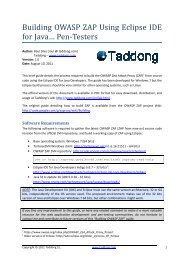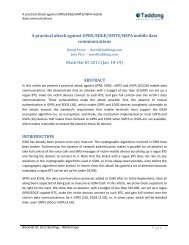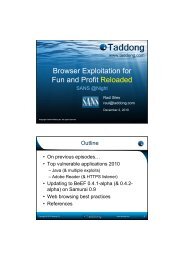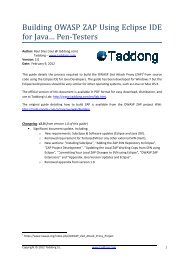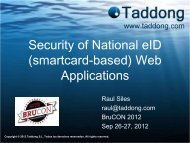SAP: Session (Fixation) Attacks and Protections - Black Hat
SAP: Session (Fixation) Attacks and Protections - Black Hat
SAP: Session (Fixation) Attacks and Protections - Black Hat
- No tags were found...
You also want an ePaper? Increase the reach of your titles
YUMPU automatically turns print PDFs into web optimized ePapers that Google loves.
UPDATEDwww.taddong.com<strong>SAP</strong>: <strong>Session</strong> (<strong>Fixation</strong>)<strong>Attacks</strong> <strong>and</strong> <strong>Protections</strong>(in Web Applications)Raul Silesraul@taddong.comMarch 17, 2011<strong>Black</strong> <strong>Hat</strong> Europe 2011Copyright © 2011 Taddong S.L. Todos los derechos reservados. All rights reserved.
Outline• <strong>Session</strong> management <strong>and</strong> web security• <strong>Session</strong> fixation– Discovery <strong>and</strong> exploitation (for pen-testers)• Case studies1. Joomla! open-source CMS2. Commercial web application server (updated)3. World’s leader in business software (<strong>SAP</strong>)• Conclusions <strong>and</strong> future researchCopyright © 2011 Taddong S.L. www.taddong.com2
<strong>Session</strong>s in Web Applications• A web session is a sequence of HTTP request<strong>and</strong> response transactions associated to thesame user• Modern <strong>and</strong> complex web applications require toretain information or keep the state of each userfor the duration of multiple requests• <strong>Session</strong>s provide the ability to establish variables,such as access rights <strong>and</strong> localization settings,which will apply to every <strong>and</strong> each interaction auser has with the web application until sheterminates her sessionCopyright © 2011 Taddong S.L. www.taddong.com3
<strong>Session</strong> Management in Web-Apps• HTTP is a stateless protocol (RFC2616)• <strong>Session</strong> tracking capabilities built on top ofHTTP (session IDs or tokens)• Key & core component of web-apps:Pre-Auth<strong>Session</strong>sAuthentication<strong>Session</strong>ManagementAccess Control<strong>Session</strong>finalizationAre there any security risks? Copyright © 2011 Taddong S.L. www.taddong.com4
OWASP Top 10 2010• The Top 10 Most Critical Web Application Security Risks:http://owasptop10.googlecode.com/files/OWASP Top 10 - 2010.pdfCopyright © 2011 Taddong S.L. www.taddong.com5
OWASP Top 10 2010 – A3Copyright © 2011 Taddong S.L. www.taddong.com6
WASC Threat Clasification v2.0• WASC-18: Credential & <strong>Session</strong> Prediction– <strong>Session</strong> ID disclosure <strong>and</strong>/or interception– <strong>Session</strong> ID prediction or brute-forcing– <strong>Session</strong> hijacking (sidejacking)• WASC-37: <strong>Session</strong> <strong>Fixation</strong>• WASC-47: Insufficient <strong>Session</strong> Expirationhttp://www.webappsec.org/projects/threat/Copyright © 2011 Taddong S.L. www.taddong.com7
<strong>Session</strong> <strong>Fixation</strong>• Discovered <strong>and</strong>/or publicized at the end of2002 by Mitja Kolšek– Obtaining vs. “Fixing” a valid session ID• The attacker fixes the session ID before thevictim logs in to the target web-app• Types: permissive <strong>and</strong> strict session mgmt.• State-of-the-art (after 9 years)?http://www.acrossecurity.com/papers/session_fixation.pdfCopyright © 2011 Taddong S.L. www.taddong.com8
What <strong>Session</strong> <strong>Fixation</strong> Should Be?Obsession &An habit of activityor practicehttp://daretobedomestic.blogspot.com/2010/07/fixation-friday-fitness-<strong>and</strong>-arms.htmlCopyright © 2011 Taddong S.L. www.taddong.com9
<strong>Session</strong> <strong>Fixation</strong> Discovery• Evaluate session tracking pre <strong>and</strong> postauthentication(<strong>and</strong> compare)– Identify the session ID transport or exchangemechanism (web interception proxy)– Get a valid session ID (pre/post-authentication)– Fix the session ID playing the victim user role– Authenticate into the target web-app– Analyze the response post-authenticationSame session ID, or no session ID, in the response?Copyright © 2011 Taddong S.L. www.taddong.com10
<strong>Session</strong> ID Exchange (1)• Multiple mechanisms are available inHTTP to maintain session state• <strong>Session</strong> ID sent as a…– Cookie (st<strong>and</strong>ard HTTP header)– URL parameter (URL rewritting) – RFC 2396– URL argument: GET request (URL rewriting)– Body argument: POST request– Hidden form field (HTML forms)– Proprietary HTTP headerCopyright © 2011 Taddong S.L. www.taddong.com11
<strong>Session</strong> ID Exchange (2)• Cookie (st<strong>and</strong>ard HTTP header):– Cookie: id=012345; …• URL parameter: (URL rewriting)– https://portal.example.com/private;id=012345?...• URL argument (GET request):– https://portal.example.com/private?id=012345&…• Body argument (POST request):– id=012345&…• Hidden form field (HTML):– • Proprietary HTTP header:– Portal-<strong>Session</strong>-ID: id=012345Copyright © 2011 Taddong S.L. www.taddong.com12
<strong>Session</strong> ID ExchangeUsed vs. Accepted• Method used by the application vs.method(s) accepted by the application• Example:– Application uses cookies to exchange IDs, butalso acepts session IDs in URLs• Can use both: automatic URL rewriting• Clients w/o cookie capabilities or not accepting them– <strong>Session</strong> ID disclosure– Facilitates session fixation attacksCopyright © 2011 Taddong S.L. www.taddong.com13
<strong>Session</strong> <strong>Fixation</strong> Discovery SummaryHTTP request (w/o session ID)HTTP response (session ID)AuthentificationIDID(pre-authentication)Pen-testerResponse (post-authentication)HTTP request (token)<strong>Session</strong> specific dataIDWeb-AppHTTP request (token)...<strong>Session</strong> trackingAuthentication or any application privilege level changeCopyright © 2011 Taddong S.L. www.taddong.com14
The Attacker is After the…http://www.fullsailbrewing.com/client/session-l<strong>and</strong>ing-page3.pngCopyright © 2011 Taddong S.L. www.taddong.com15
<strong>Session</strong> <strong>Fixation</strong> Exploitation• Active attack for session hijacking <strong>and</strong> userimpersonation– Targeted attacks against sensitive users– Indiscriminate attacks as any legitimate user• Unauthorized access (or privilege escalationattacks) as victim user• <strong>Fixation</strong> <strong>and</strong> exploitation phases– Wait till the victim user authenticatesCopyright © 2011 Taddong S.L. www.taddong.com16
<strong>Session</strong> <strong>Fixation</strong> <strong>Attacks</strong>http://www.acrossecurity.com/papers/session_fixation.pdfCopyright © 2011 Taddong S.L. www.taddong.com17
Attack Vectors (1)• Web references or links (URLs):– Social engineering tricks: entice user to followthe link with the attacker’s session IDhttps://portal.example.com/private;sessionid=012345?...• HTTP meta tags (e.g. cookies):– Cannot be disabled in web browsershttps://portal.example.com/• Untrusted client shared environmentsCopyright © 2011 Taddong S.L. www.taddong.com18
Attack Vectors (2)• Web traffic interception & manipulation:– MitM attacks over unencrypted HTTP traffic toadd or replace legitimate session IDs– Any exchange mechanisms (single request)Set-Cookie: SESSIONID=012345; expires=Friday, 17-May-1318:45:00 GMT; ...• Cross-subdomain cooking: (design)– “domain” cookie attribute from vuln serversDNSSet-Cookie: SESSIONID=012345; domain=.example.com; ...Copyright © 2011 Taddong S.L. www.taddong.com19
Attack Vectors (3)• HTTP response splitting:– Inject session IDs (as HTTP headers)– E.g. HTTP redirectionREQ: https://portal.example.com/login\r\nSet-Cookie:SESSIONID=012345\r\nDummy-Header:RESP:HTTP/1.1 302 FoundServer: Vulnerable Server 1.0Location: https://portal.example.com/loginSet-Cookie:SESSIONID=012345Dummy-Header: /login...Copyright © 2011 Taddong S.L. www.taddong.com20
Attack Vectors (4)• Cross-Site Scripting (XSS):– Set the session IDs through JavaScript– Target web applications (or subdomain apps)– Persistent <strong>and</strong> reflective XSShttps://portal.example.com/search?q=document.cookie="SESSIONID=012345;%20path=/;%20domain=.example.com";• SQL injection:– <strong>Session</strong> management database (subtle attacks)Copyright © 2011 Taddong S.L. www.taddong.com21
<strong>Session</strong> <strong>Fixation</strong> Benefits• Bigger attack window– Initial fixation occurs pre-authentication– Victim user authenticates (long time afterwards)– Attack is exploited post-authentication (active)• Extended attack lifetime– Persistent cookies (e.g. 10 years)– Web application terminates the session– <strong>Session</strong> ID remains on the user browser waitingfor the session to be resumed (or re-launched)Copyright © 2011 Taddong S.L. www.taddong.com22
<strong>Session</strong> <strong>Fixation</strong> ExploitationSummaryHTTP request (w/o session ID)HTTP response (session ID)IDID(pre-authentication)Pen-testerIDWeb-App<strong>Session</strong> trackingVictim userIDVulnerableWeb-AppAttack vector(s): combined & target dependantCopyright © 2011 Taddong S.L. www.taddong.com23
Case StudiesCopyright © 2011 Taddong S.L. www.taddong.com24
Three Case Studies• From real-world penetration tests– Past two years: 2009-2010– Three different session fixation vulnerabilitieson three separate target web environments• How they were discovered & exploited• Real impact• Vulnerability disclosure timeline• <strong>Protections</strong>Copyright © 2011 Taddong S.L. www.taddong.com25
Discovering Security Vulnerabilitieshttp://dilbert.com/dyn/str_strip/000000000/00000000/0000000/000000/00000/0000/300/376/376.strip.sunday.gifCopyright © 2011 Taddong S.L. www.taddong.com26
Case Study #1Joomla! Open-Source CMSCopyright © 2011 Taddong S.L. www.taddong.com27
#1 Summary• <strong>Session</strong> fixation in Joomla!, a widely usedopen-source CMS• Affected versions: 1.5.x – 1.5.15• Vulnerability ID: 20100423 (TAD-2010-001)• Notified: November 2009• Release date: April 2010First “sessationfixation” vuln http://developer.joomla.org/security/news/309-20100423-core-sessation-fixation.htmlCopyright © 2011 Taddong S.L. www.taddong.com28
#1 Discovery <strong>and</strong> Exploitation• Target HTTPS-only web application– Public & private sections (registered users)– Built-in Joomla! core session management– Authentication: e-National ID card or user/pass• MD5 hashes for session ID <strong>and</strong> value– Ignore it: meaning & purpose are not required– Discovered through a blackbox pen-test but…– Source-code available: whitebox pen-testCopyright © 2011 Taddong S.L. www.taddong.com29
#1 Impact• Open-source CMS– Non-profit organizations, academic institutions,<strong>and</strong> non-business related <strong>and</strong> …– … business critical web-applications• Commercial companies <strong>and</strong> governments• St<strong>and</strong>alone, source-code customizations, <strong>and</strong> otherframeworks (internally <strong>and</strong> publicly)• All 1.5.x Joomla! versions up to 1.5.15– Depending on criticality of web applicationCopyright © 2011 Taddong S.L. www.taddong.com30
#1 Vulnerability Disclosure Timeline• Lessons learned from vulnerabilitynotifications, h<strong>and</strong>ling, <strong>and</strong> disclosure– Definitely, open for improvement!!• Advisory says reported on March 25, 2010,when it should say Nov 2009• “The Seven Deadly Sins of SecurityVulnerability Reporting” blog posthttp://blog.taddong.com/2010/08/seven-deadly-sins-ofsecurity.htmlCopyright © 2011 Taddong S.L. www.taddong.com31
#1 <strong>Protections</strong>• Web applications based on Joomla! mustupgrade to the latest Joomla! version(1.5.16 or later)Copyright © 2011 Taddong S.L. www.taddong.com32
Case Study #2Commercial Web Application ServerUPDATEDCopyright © 2011 Taddong S.L. www.taddong.com33
#2 Summary• <strong>Session</strong> fixation vulnerability on a web-appbased on Oracle/Bea WebLogic Portal/Server– HTTP vs. HTTPS misbehavior• Affected versions: “J2EE web-apps”• Vulnerability: Misconfiguration• Notified: December 2010Others?• Release date: Today! - March 2011J2EE web application deployment best practicesCopyright © 2011 Taddong S.L. www.taddong.com34
#2 Discovery <strong>and</strong> Exploitation (1)• Complex & recently redesigned web-app• Public section + private section (auth)• Java-based cookie (JSESSIONID)– Pre-authentication– “domain” & “path” attributes+50 chars& r<strong>and</strong>omSet-Cookie: JSESSIONID=Fz5f…qMql;domain=.example.com; path=/• Authentication (POST & HTTPS & cookie):https://portal.example.com/private/miPortalCopyright © 2011 Taddong S.L. www.taddong.com35
#2 Discovery <strong>and</strong> Exploitation (2)• Successful authentication (post-auth):Set-Cookie: _WL_AUTHCOOKIE_JSESSIONID=G4lD…vQ14; path=/; secure• Any previous value is renewed– _WL_AUTHCOOKIE_JSESSIONID• Very common scenario: two cookies– Pre-auth (unsecure): always (www, portal, etc)– Post-auth (secure): portal only (SSL) & renewed<strong>Session</strong> ID (authenticated users) = JSESSIONID +_WL_AUTHCOOKIE_JSESSIONIDCopyright © 2011 Taddong S.L. www.taddong.com36
#2 Discovery <strong>and</strong> Exploitation (3)• All links from “www” to “portal” are HTTPS– But HTTP is also allowed in “portal”• What is used for session ID verification whenaccessing “authenticated resources”?– Common sense: both cookies (! in reality)• HTTPS behavior:1. Both cookies: OKMissing orexpired2. JSESSIONID bad: redirect to login & renewed3. AUTH_JSESSIONID bad: 401 Basic?Copyright © 2011 Taddong S.L. www.taddong.com37
#2 Discovery <strong>and</strong> Exploitation (4)• HTTP behavior:– Once authenticated, HTTPS requires both– HTTP only makes use of JSESSIONID• All resources available through HTTP • JSESSIONID is enough to associate theweb request (HTTP) to an auth session12• Remember, JSESSIONID is not renewed• Discovered on WebLogic Portal version 10.3Even simpler attacks as JSESSIONID is disclosed via HTTPCopyright © 2011 Taddong S.L. www.taddong.com38
#2 Impact• Three possible scenarios:– High: commercial web-app server foundvulnerable (all web-apps)– Mid: vulnerability due to misconfiguration of thecommercial web-app serverHow easy is to introduce the wrong setting?– Low: only the specific web-app it was discoveredin is vulnerable• Even if not 0-day, subtle sample of HTTP(S)<strong>and</strong> session management misconfigurationCopyright © 2011 Taddong S.L. www.taddong.com39
WebLogic HTTPS Enforcement (1)• web.xml:SSL not requiredNONE• HTTPS is not enforced by WebLogic– User dependent: “http://” or “https://” links– NONE: HTTPS not enforced (HTTP allowed)– CONFIDENTIAL: Ensure confidentiality– INTEGRAL: Ensure integritySSLTLSCopyright © 2011 Taddong S.L. www.taddong.com40
WebLogic HTTPS Enforcement (2)• HTTPS on the web or web-app server(s)?– Apache 2.2.x vs. WebLogic Portal 10.3• If HTTPS is not enforced by the WebLogicconfiguration (“NONE”), then:– Because resources are available though HTTP– …<strong>and</strong> therefore, the secure cookie will never besent by the web browser• _WL_AUTHCOOKIE_JSESSIONID– …JSESSIONID is the only ID required toassociate requests to authenticated sessionsCopyright © 2011 Taddong S.L. www.taddong.com41
WebLogic HTTPS Enforcement (3)• Be careful with the exceptions in web.xml: …All/CONFIDENTIAL …/public/*…NONE…Copyright © 2011 Taddong S.L. www.taddong.comDefault isNONE for all:url-pattern = *42
#2 Vulnerability Disclosure Timeline• Vendor notified in early December 2010– Quick analysis & limited target information– Conclusion: Specific to target environment• Mid-February 2011: full configuration details– Re-analyzed for confirmation• Early/Mid-March 2011:– Conclusion: HTTPS misconfiguration & lack ofsession ID regeneration (developer’s h<strong>and</strong>s)Web-app source code for in-depth analysis <strong>and</strong> ratification?Copyright © 2011 Taddong S.L. www.taddong.com43
#2 <strong>Protections</strong> (1)• Separate public & private web environments– Server, IP, hostname, <strong>and</strong> domain– <strong>Session</strong> management infrastructure• Pen-testers must try this!! (lessons learned)– HTTP vs. HTTPS inconsistencies– <strong>Session</strong> management verifications (# cookies)• Even if available only through HTTPS?• Security-related developer’s documentationimprovements (session fixation & HTTPS)Credit: Oracle April 2011 CPUCopyright © 2011 Taddong S.L. www.taddong.com44
#2 <strong>Protections</strong> (2)HTTPS Secure Cookie• Default in config.xml (even if not defined):• WebLogic server instance sends a newsecure cookie for protected resources:– _WL_AUTHCOOKIE_JSESSIONID• Securely access HTTPS resources in auser session (even initiated using HTTP)It is m<strong>and</strong>atory to set both settings: (forSSL/TLS) <strong>and</strong> AuthCookieEnabled (default)Copyright © 2011 Taddong S.L. www.taddong.com45
#2 <strong>Protections</strong> (3)Authentication Options• Programmatic authorization/security:– Developer custom code via login() API• E.g. weblogic.security.services.Authentication.login(h);– Must take into account ID regeneration manually• Declarative authorization/security:– WebLogic built-in authentication (ServletContainer) - E.g. – JSESSIONID is automatically regenerated afterauthenticationhttp://download.oracle.com/docs/cd/E13222_01/wls/docs103/security/thin_client.htmlCopyright © 2011 Taddong S.L. www.taddong.com46
#2 <strong>Protections</strong> (4)WebLogic <strong>Session</strong> <strong>Fixation</strong>• WebLogic Server provides the following APIto regenerate the session ID after asuccessful authentication:ServletAuthentication.generateNew<strong>Session</strong>ID(request);• Security on the web developer’s h<strong>and</strong>s• Documentation must include best practices– Will be added as a result of this discoveryhttp://download.oracle.com/docs/cd/E11035_01/wls100/javadocs/weblogic/servlet/security/ServletAuthentication.htmlCopyright © 2011 Taddong S.L. www.taddong.com47
#2 <strong>Protections</strong> (5)HTTPS & Auth Enforcement• Set both simultaneously in web.xml: …All/12CONFIDENTIALauthenticateduserFORM…Copyright © 2011 Taddong S.L. www.taddong.comUser-data &authconstraints48
#2 <strong>Protections</strong> (6)Summary• Too many options & too much flexibility!• Recommended best practices:– All sensitive resources must be protected byHTTPS (<strong>and</strong> not accessible via HTTP) at theweb application server level (e.g. WebLogic)• Use the default secure authentication cookie– Enforce HTTPS & authentication altogether– Java servlets must invalidate the session (thusrenew the session ID) just after completingauthentication• Programmatically or declaratively (default)Copyright © 2011 Taddong S.L. www.taddong.com49
#2 <strong>Protections</strong> (7)Automatic?• Could we thoroughly link the custom web-appauthentication code <strong>and</strong> session managementcapabilities to always enforce HTTPS <strong>and</strong> sessionID renewal?• Default framework behavior vs. developer’s code• At the industry level (specifications & implementations)Pre-Auth<strong>Session</strong>sHTTPSAuthentication<strong>Session</strong>ManagementSecureAccessHow to securely link these three components?Copyright © 2011 Taddong S.L. www.taddong.com50
#2 <strong>Protections</strong> (8)Industry st<strong>and</strong>ardsOpen to !=interpretations• Java Servlet Specification (J2EE) - Defaults– <strong>Session</strong>s have an application scope• Share the same session• “7.3. <strong>Session</strong> Scope” (Java Servlet Spec v3.0 – pg.57)– Requirement: HTTP & HTTPS on the same app– St<strong>and</strong>ard document description (.XML)• Independent authentication <strong>and</strong> encryption elements– Specifications vs. security best practices• Not all combinations are desired– It is all about protected resources!!AuthenticationEncryption<strong>Session</strong> mgmt.See also “Java Servlet Spec” for case #3 on whitepaperCopyright © 2011 Taddong S.L. www.taddong.com51
Case Study #3World’s Leader in Business SoftwareCopyright © 2011 Taddong S.L. www.taddong.com52
#3 Summary• <strong>Session</strong> fixation in the <strong>SAP</strong> J2EE Engineaffecting the core <strong>SAP</strong> NetWeaver platform• Affected versions: 6.40 - 7.20• Vuln ID: <strong>SAP</strong> Security Note 1310561(TAD-2011-002)• Notified: July 2009• Release date: December 2010 (<strong>SAP</strong> SMP)https://websmp130.sap-ag.de/sap/support/notes/1310561Copyright © 2011 Taddong S.L. www.taddong.com53
#3 Discovery <strong>and</strong> Exploitation (1)• Large penetration test (net, web-app, wi-fi)• Some of the target servers were the Intranetwebsite <strong>and</strong> the <strong>SAP</strong> systems– Critical business processes <strong>and</strong> activities• This website contained a link (used byemployees) to the <strong>SAP</strong> Portal (HTTP)– http(s)://intranet.example.com (NTLM auth)– http://portal.example.com (<strong>SAP</strong> NW Portal)• <strong>SAP</strong> Portal redirects to HTTPS versionCopyright © 2011 Taddong S.L. www.taddong.com54
#3 Discovery <strong>and</strong> Exploitation (2)• HTTP 307: “Temporary Redirect”– https://portal.example.com/irj/portal• The common & “innocent” HTTP redirectiondiscloses all the session cookies: (network traffic)– saplb_*, PortalAlias & JSESSIONID• Even if the reference is HTTPS, the lack of the“secure” attribute makes possible to MitM it <strong>and</strong>relay fictitious HTTP to HTTPS (e.g. SSLstrip)• Target <strong>SAP</strong> Portal supported client-based digitalcertificates (smart card ID) or user/password authCopyright © 2011 Taddong S.L. www.taddong.com55
#3 Discovery <strong>and</strong> Exploitation (3)• Pen-tester obtains a valid session ID (pre)• The session ID is “fixed” in the victimbrowser (ARP poisoning & traffic control)– MitM by injecting the session ID in the cookieheaders of the HTTP response (307 redirect)• The user authenticates in the <strong>SAP</strong> Portal– <strong>Session</strong> ID does not change (session fixation)• Pen-Tester gets full access to victim’ssession (business critical data <strong>and</strong> actions)Copyright © 2011 Taddong S.L. www.taddong.com56
#3 Discovery <strong>and</strong> Exploitation (4)Copyright © 2011 Taddong S.L. www.taddong.com57
http://4.bp.blogspot.com/_qu-NsGz9y5E/SdfD1QbBY5I/AAAAAAAABX0/cyMTSOyME-A/s400/The_<strong>Session</strong>_Logo.jpgCopyright © 2011 Taddong S.L. www.taddong.com58
#3 Discovery <strong>and</strong> Exploitation (5)• Attacker only had to reuse the followingspecific set of target cookies:Cookie:saplb_*=(J2EE01234567)01234567;PortalAlias=portal;JSESSIONID=(J2EE01234567)ID0123456789DB01234567890123456789End;MY<strong>SAP</strong>SSO2=AjEx…(very long string)…ewCw%3D;<strong>SAP</strong>WP_active=1Copyright © 2011 Taddong S.L. www.taddong.com59
#3 Discovery <strong>and</strong> Exploitation (6)• <strong>SAP</strong> NW Portal version 6.4.200607310245:– Server: <strong>SAP</strong> Web Application Server (ICM)– Server: <strong>SAP</strong> J2EE Engine/6.40– PortalVersion:"6.4.200607310245”• <strong>SAP</strong> Portal session IDs available preauthentication• Post-authentication, session IDs do notchange (session fixation)• Choose targets selectively (business role)Copyright © 2011 Taddong S.L. www.taddong.com60
#3 Impact (1)• Hijack any <strong>SAP</strong> user (or admin) session– Unauthorized access to <strong>SAP</strong> Portal <strong>and</strong> other<strong>SAP</strong> applications <strong>and</strong> modules– <strong>SAP</strong> NetWeaver is <strong>SAP</strong>’s integrated technologyplatform & technical foundation for all <strong>SAP</strong> apps– Key business users (target core business)• Real-world impact: who could be affected?– <strong>SAP</strong> AG: world’s leader in enterprise biz SW– +109,000 customers in 120 countries– +140,000 installations & +2,400 cert partnersCopyright © 2011 Taddong S.L. www.taddong.com61
<strong>SAP</strong> ArchitectureCopyright © 2011 Taddong S.L. www.taddong.com62
#3 Impact (2)• Direct impact of software-based <strong>and</strong> webservices-based business activities of thous<strong>and</strong>sof organizations <strong>and</strong> companies worldwide• <strong>Session</strong> fixation might impact web-app design– In-depth architecture analysis & 3 rd -parties & redesign– Minor change can break other components– E.g. User impersonation between applications• SSO (Single Sign On) or session management tricks– E.g. Software components that receive <strong>and</strong> use IDs• Without capabilities to discern if it is valid or notBypass the most advanced authentication mechanismsCopyright © 2011 Taddong S.L. www.taddong.com63
#3 Impact (3)• SW maintenance & support strategy: 7-2– 7 years mainstream + 2 years extended– Fixes for new & legacy versions (production)Copyright © 2011 Taddong S.L. www.taddong.com64
#3 Vulnerability Disclosure Timeline (1)• Complexity of modern web architectures<strong>and</strong> broad vulnerability scope = 1,5 years• Reported on early July 2009 & ratified– First deadline: 2 months (best case scenario)+2,5+4• Mid Sep’09 difficulties identified (stability)• Nov’09: estimated release on Jan/Feb’10– Responsible disclosure (plans) & real impact– Initial technical solution being testedMeanwhile environments remain vulnerable…Copyright © 2011 Taddong S.L. www.taddong.com65
#3 Vulnerability Disclosure Timeline (2)+7+9+13+18+21• End Jan’10: solution still not available– Issue escalated internally– Several months required (all affected releases)• Mar’10: fixes for all cases expected +Sep’10– Issues found on legacy releases– Partial fixes for specific CUs under evaluation• Aug’10: meeting date for Nov’10 (disclosure)• Dec’10: vuln & fix releases (CUs & partners)• Mar’11: implementation time of 3 monthsCopyright © 2011 Taddong S.L. www.taddong.com66
<strong>SAP</strong> Disclosure Guidelines (1)• <strong>SAP</strong> disclosure guidelines details:– Published after this specific finding– “Since the integrity <strong>and</strong> security of businessoperations is crucial for businesses in allindustries, <strong>SAP</strong> as a provider of businesssoftware is absolutely committed tomaintaining the highest possible level ofsecurity within its products.”– What is the right balance between full security<strong>and</strong> fast disclosure?Other researchers can find it:!= motivations (see case #1)Copyright © 2011 Taddong S.L. www.taddong.com67
<strong>SAP</strong> Disclosure Guidelines (2)• Fix <strong>and</strong> vuln disclosure details <strong>and</strong> timing:New <strong>SAP</strong> security program: highlight securitynotes, periodic releases & creditIs the all or nothing approach theright approximation?Copyright © 2011 Taddong S.L. www.taddong.com68
#3 <strong>Protections</strong> (1)• Monthly Patch Day (since Sep’2010)• <strong>SAP</strong> ACK to security researchers:• <strong>SAP</strong> Security Note 1310561– December 2010Third oldest #id, after1175239 (related) &1151410– https://websmp130.sap-ag.de/sap/support/notes/1310561 (<strong>SAP</strong> Service Marketplace)http://www.sdn.sap.com/irj/sdn/index?rid=/webcontent/uuid/c05604f6-4eb3-2d10-eea7-ceb666083a6aCopyright © 2011 Taddong S.L. www.taddong.com69
#3 <strong>Protections</strong> (2)• Enable “<strong>Session</strong>IdRegenerationEnabled”– <strong>SAP</strong> Security Note 1310561– Web Container Service property– Two cookies required to identify sessions:JSESSIONID & JSESSIONMARKID (“secure”)– The new “secure” session ID is renewed onevery successful login– Disabled by default but…– Enabled in +7.11 SP06 & all SPs 7.20 & 7.30– Specific scenarios may require extra stepsCopyright © 2011 Taddong S.L. www.taddong.com70
#3 <strong>Protections</strong> (3)• Use HTTPS-only links & remove HTTPsupport in <strong>SAP</strong> Portal• Enable “SystemCookiesHTTPSProtection”– <strong>SAP</strong> Security Notes 1019335 & 1020365– HTTP Provider Service property– Sets the “secure” attribute for session <strong>and</strong> loadbalancing cookies (JSESSIONID & saplb)– Available in 6.40 SP21 & 7.0 SP14– Disabled by default Vendor conservative settings & backwardcompatibility. Security teams!!Copyright © 2011 Taddong S.L. www.taddong.com71
#3 <strong>Protections</strong> (4)• Enable “<strong>Session</strong>IPProtectionEnabled”– Web Container Service property• Manages J2EE web components– HTTP session cannot be accessed fromdifferent IP addresses. Only requests from theIP addr that started the session are processed– Disabled by default– If front proxy or load balancer is used• Configure the “ClientIpHeaderName” property of theHTTP Provider Service (e.g. relay “X-Forwarded-For”header)Copyright © 2011 Taddong S.L. www.taddong.com72
ConclusionsCopyright © 2011 Taddong S.L. www.taddong.com73
<strong>Session</strong> <strong>Fixation</strong> <strong>Protections</strong>• Renew session ID after privilege level changes• Lack of link between authentication <strong>and</strong> sessionmanagement capabilities (best practices only)– Web developer’s h<strong>and</strong>s (e.g. PHP or Java or .NET…)• Limit accepted session tracking mechanisms• HTTPS everywhere• <strong>Session</strong> ID available only post-authentication• Bind session ID to other user properties• Isolate critical web-apps on its own domain• Very restrictive cookie attributesCopyright © 2011 Taddong S.L. www.taddong.com74
Conclusions (1)• <strong>Session</strong> fixation still prevalent in 2010– Open-source projects, commercial web applicationframeworks, <strong>and</strong> mission critical business platforms• Thous<strong>and</strong>s of critical <strong>and</strong> business-relatedweb environments affected worldwide• Entry point to get unauthorized access tobusiness critical data <strong>and</strong> infrastructures– Targeted, criminal, <strong>and</strong> corporate espionage• Multiple exploitation methods availableCopyright © 2011 Taddong S.L. www.taddong.com75
Conclusions (2)• <strong>Session</strong> attacks can bypass even the mostadvanced authentication mechanisms• <strong>Session</strong> ID is equivalent to…– Password– Passphrase– Digital certificates– Smart cards– Fingerprint– Eye retinaCopyright © 2011 Taddong S.L. www.taddong.com76
Conclusions (3)• Impact on the web-app design <strong>and</strong> on multiplemodules (<strong>and</strong> 3 rd -party components)– Complexity of web-apps <strong>and</strong> core nature ofsession management infrastructures– Minor misconfiguration introduces vulnerability?– How easy is to fix session fixation?– Plan <strong>and</strong> test early in design <strong>and</strong> development• Promote (continuous) testing for session fixationflaws, development awareness, <strong>and</strong> improvevulnerability h<strong>and</strong>ling <strong>and</strong> disclosureCopyright © 2011 Taddong S.L. www.taddong.com77
Future Research• <strong>Session</strong> fixation state-of-the-art on the wild– Widely used Internet services <strong>and</strong> selectedsample of critical web applications– Valid user account on the target web-app• Manual techniques vs. semi-automated toolfor discovery <strong>and</strong> basic exploitation– Automate verification <strong>and</strong> extend testing• Authentication <strong>and</strong> privilege level changesCopyright © 2011 Taddong S.L. www.taddong.com78
Questions? Copyright © 2011 Taddong S.L. www.taddong.com79
www.taddong.comBlog:blog.taddong.comTwitter: @taddongRaul SilesFounder & Senior Security Analystraul@taddong.com




